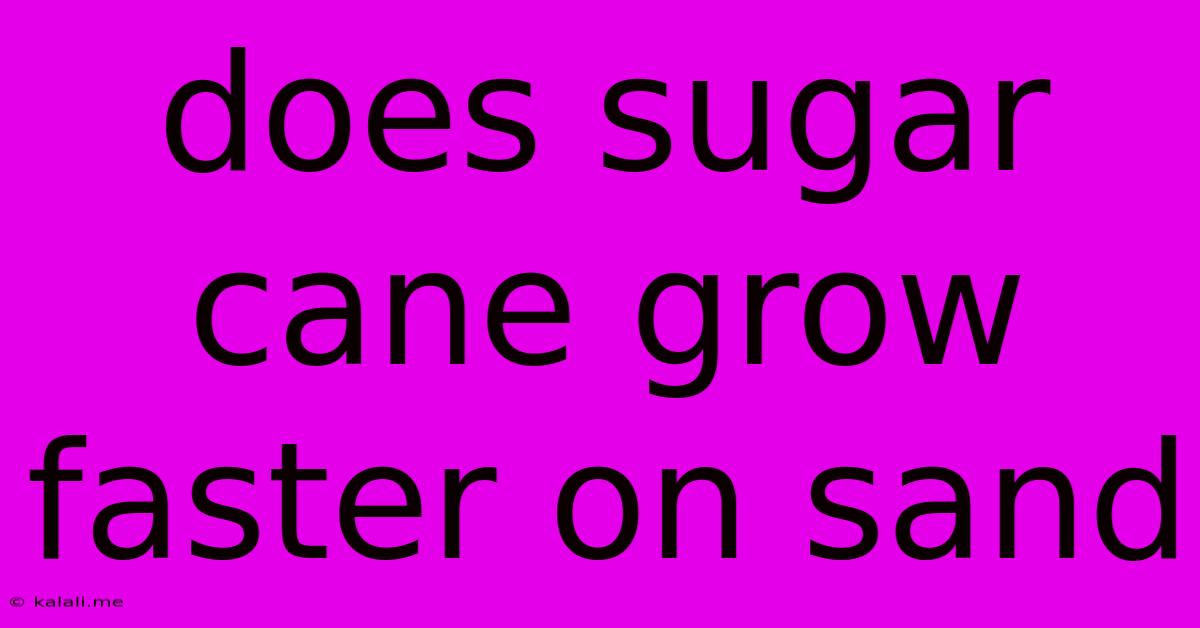Does Sugar Cane Grow Faster On Sand
Kalali
May 19, 2025 · 3 min read

Table of Contents
Does Sugarcane Grow Faster on Sand? A Deep Dive into Soil Composition and Sugarcane Yield
Sugarcane, a vital crop globally for its sugar and biofuel production, thrives best under specific conditions. One crucial factor influencing its growth rate is soil composition. This article explores whether sugarcane grows faster on sandy soil compared to other soil types, examining the advantages and disadvantages. Understanding the ideal soil properties for optimal sugarcane growth is key to maximizing yields and efficiency.
What Makes a Good Soil for Sugarcane?
Sugarcane requires well-drained, fertile soil rich in organic matter. While sandy soil offers excellent drainage, it's not the whole picture. The ideal soil for sugarcane is a loam, a balanced mix of sand, silt, and clay. This balance provides the necessary drainage to prevent waterlogging while retaining sufficient moisture and nutrients.
Advantages of Sandy Soil for Sugarcane
- Excellent Drainage: Sandy soil allows for exceptional water drainage, crucial for preventing root rot, a major sugarcane disease. Excessive moisture can suffocate roots, hindering nutrient uptake and growth. This benefit of sandy soil is particularly vital in areas with high rainfall.
- Ease of Cultivation: Sandy soils are generally easier to till and cultivate, reducing machinery wear and fuel consumption. This makes planting and harvesting processes smoother and more efficient.
- Faster Root Penetration: Sugarcane roots can penetrate sandy soil more easily than heavier clay soils, leading to faster establishment and potentially quicker uptake of water and nutrients from the surface layers.
Disadvantages of Sandy Soil for Sugarcane
- Poor Nutrient Retention: Sandy soil's inherent characteristic is its low nutrient retention capacity. Essential nutrients like nitrogen, phosphorus, and potassium leach quickly, requiring frequent fertilization and potentially increasing production costs. This necessitates careful nutrient management strategies.
- Lower Water Retention: While excellent drainage is beneficial, sandy soil's poor water retention capacity means sugarcane may require more frequent irrigation, increasing water usage and potentially production expenses. This is especially true in drier climates.
- Susceptibility to Erosion: Sandy soils are susceptible to wind and water erosion, potentially leading to soil loss and decreased crop yield. Appropriate soil conservation practices, such as cover cropping, are vital to mitigate this risk.
Comparing Sandy Soil to Other Soil Types
While sandy soil offers advantages like drainage and ease of cultivation, it's important to compare it to other suitable soil types for sugarcane growth. Clay soils, while retaining moisture and nutrients well, can be prone to waterlogging and difficult to cultivate. Silty soils offer a balance but might not have the drainage benefits of sandy soil. Loamy soils, as mentioned earlier, provide the optimal balance of drainage, nutrient retention, and ease of cultivation.
The Verdict: Does Sugarcane Grow Faster on Sand?
Sugarcane might establish faster on sandy soil due to better root penetration, but this doesn't automatically translate to faster overall growth. The lack of nutrient retention and water holding capacity in sandy soil can ultimately limit its yield compared to a well-balanced loam. Therefore, while sandy soil offers some advantages, it's unlikely to result in significantly faster growth compared to a fertile loam with appropriate irrigation and fertilization. The ultimate growth rate depends heavily on factors beyond soil type alone, including climate, variety of sugarcane, and proper agricultural practices. Choosing the right soil for sugarcane production involves considering the trade-offs and employing suitable management techniques to optimize yield and efficiency.
Latest Posts
Latest Posts
-
Did Churchill Really Ride The Underground
May 19, 2025
-
Can You Put A Plate In The Oven
May 19, 2025
-
How To Strip Paint Off A Deck
May 19, 2025
-
Why Did Voldemort Kill The Potters
May 19, 2025
-
How To Remove A Velux Window Blind
May 19, 2025
Related Post
Thank you for visiting our website which covers about Does Sugar Cane Grow Faster On Sand . We hope the information provided has been useful to you. Feel free to contact us if you have any questions or need further assistance. See you next time and don't miss to bookmark.